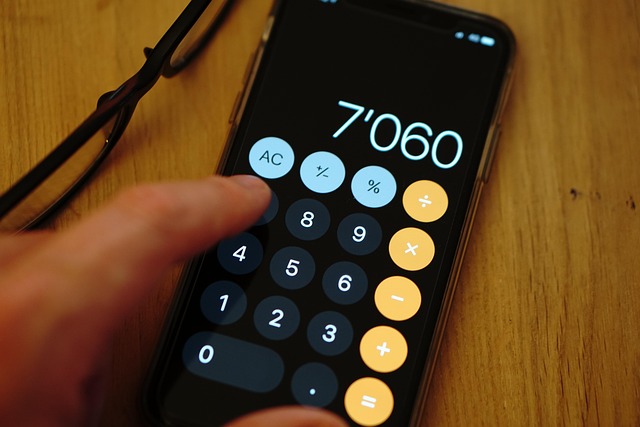How to Calculate Volume in Trading in 2025
Author: Jameson Richman Expert
Published On: 2025-09-05
Prepared by Jameson Richman and our team of experts with over a decade of experience in cryptocurrency and digital asset analysis. Learn more about us.
Understanding how to calculate trading volume is fundamental for traders and investors aiming to navigate the increasingly sophisticated and data-driven financial markets of 2025. Volume, in this context, refers to the total number of units—be they shares, futures contracts, options, or digital assets—that are exchanged within a specific timeframe. Accurate volume analysis provides critical insights into market liquidity, investor interest, momentum, and potential price movements. As markets evolve with technological advancements, mastering volume calculation becomes indispensable for developing robust trading strategies, managing risk effectively, and enhancing overall performance. From traditional stock exchanges to decentralized cryptocurrencies, volume metrics serve as a vital indicator of market health and participant engagement.
In 2025, the significance of trading volume extends beyond simple numeric representation; it offers a window into underlying market dynamics and participant behavior. Real-time, granular data from multiple trading platforms, combined with sophisticated analytical tools—including AI-driven analytics—enable traders to interpret volume movements with extraordinary precision. Understanding the nuances across different markets—such as equities, commodities, forex, and digital assets—and leveraging the latest technological innovations in data retrieval and analysis are crucial for accurate volume calculations and strategic decision-making in today’s fast-paced environment.

Understanding the Basics of Trading Volume
Trading volume is fundamentally the aggregate number of units—such as shares, futures contracts, options, or tokens—that are exchanged during a specific period. It acts as a key barometer of market activity and strength. Typically expressed as total units traded over a chosen interval—daily, hourly, minute-by-minute—it reflects the level of participation and can serve as an indicator of trend sustainability or exhaustion. For example, a surge in volume accompanying a price rally often signifies strong buying interest, increasing the likelihood of a sustainable upward trend. Conversely, high volume during a decline may indicate panic selling or institutional liquidation, signaling potential reversals or market shifts.
Low volume periods suggest a lack of conviction—often leading to false breakouts or reversals—highlighting the importance of volume confirmation for technical signals. As markets become more fragmented and influence by high-frequency trading (HFT), understanding these subtle nuances helps traders avoid fake signals and make more informed decisions based on genuine market activity. Volume also validates technical breakouts—breakouts with high volume tend to be more reliable, reducing the risk of false positives and enabling traders to act with greater confidence.
Methods of Calculating Trading Volume
There are several methods to calculate trading volume, each suited to different asset classes and trading environments. The most straightforward involves summing the total number of units exchanged during a specific timeframe. For example, if 150,000 shares of stock XYZ are traded in a day, the daily volume is 150,000 shares. In the cryptocurrency domain, volume is often measured in real-time, aggregating data from multiple exchanges to reflect current market activity—a necessity due to the fragmented liquidity landscape of digital assets. This approach provides a more comprehensive picture of overall market activity and liquidity.
Using Market Data Feeds and APIs
Modern trading platforms and financial data providers deliver comprehensive market data feeds that include volume information. These feeds aggregate data from multiple sources, ensuring both accuracy and timeliness. Application Programming Interfaces (APIs) provided by platforms like Binance, Coinbase, Interactive Brokers, and others allow traders and developers to access raw volume data programmatically. This enables integration into custom analytical tools, trading bots, and automated strategies. For instance, Binance’s API facilitates fetching real-time trading volumes for specific cryptocurrency pairs, which can be utilized to monitor liquidity, identify accumulation or distribution phases, and develop high-frequency trading algorithms. Leveraging these APIs allows for seamless, scalable, and automated data collection necessary for precision trading in 2025.
Volume Weighted Average Price (VWAP)
Beyond raw volume figures, traders employ the Volume Weighted Average Price (VWAP) as a critical analytical metric. VWAP provides the average price at which trades have occurred during a specified period, weighted by volume, offering a more accurate reflection of trading activity than simple averages. It is widely used by institutional traders to evaluate market quality and execute large orders with minimal market impact. The calculation involves summing the product of each trade’s price and volume during the period, then dividing by the total volume. VWAP acts as a dynamic benchmark—prices trading above VWAP suggest bullish sentiment, while prices below may indicate bearish pressure. Its application is especially relevant for assessing intraday trends, optimal trade entry points, and institutional execution strategies.
Calculating Volume for Different Asset Classes
Different asset classes employ varied approaches for volume calculation, influenced by their trading mechanisms and platforms. In equities markets, volume is expressed as the total number of shares traded daily, reported by stock exchanges such as NYSE or NASDAQ. Commodities, like oil or gold, are traded via futures contracts or spot transactions, with volume representing the total number of contracts or units exchanged. Cryptocurrencies, with 24/7 trading, demand real-time volume data in digital units like BTC, ETH, or altcoins, sourced from multiple exchanges and often aggregated through data providers or analytics platforms. Recognizing and understanding these differences is crucial for assessing liquidity, market depth, and participation across diverse markets and for tailoring strategies accordingly.
Cryptocurrency Trading Volume
Crypto markets are characterized by high volatility, decentralization, and continuous trading hours, making real-time volume analysis especially critical. Traders rely heavily on exchange-specific data, accessible via APIs, to gauge true market activity. Leading platforms such as Binance, Mexc, Bitget, and Bybit provide detailed volume metrics for each trading pair, which can be integrated into analytical dashboards or automated trading systems. Given the prevalence of wash trading and potential data manipulation, it’s prudent to cross-verify volume figures across multiple reputable exchanges and data aggregators. Transparency, data integrity, and an understanding of exchange-specific behaviors are key to making informed decisions in this rapidly evolving space, especially when designing strategies around liquid digital assets.
Register here for Binance’s API access, and explore other platforms like Mexc, Bitget, and Bybit through their referral links to obtain reliable, real-time volume data essential for effective trading and comprehensive market analysis.

Interpreting Trading Volume Data
Once volume data is collected, interpreting it accurately is essential for effective decision-making. High volume coupled with rising prices often signals strong bullish momentum, indicating the likelihood of trend continuation. Conversely, high volume during a decline may reflect panic selling or institutional liquidation, signaling potential reversals. Low volume, especially during periods of price consolidation or sideways movement, suggests a lack of conviction or participant interest, often resulting in range-bound or choppy markets. Recognizing these patterns helps traders differentiate between genuine moves and false signals, refining entry and exit strategies. Advanced traders combine volume spikes with candlestick patterns, divergences, and price gaps—key technical signals—to anticipate reversals or breakouts with greater confidence and reduce the risk of whipsaws.
Technical Indicators Related to Volume
Technical indicators that incorporate volume are invaluable for confirming trend strength, identifying divergences, and timing entries/exits. Notable among these are:
- On-Balance Volume (OBV): This indicator accumulates volume on upward moves and subtracts volume on downward moves, helping identify whether volume supports the current trend or diverges from it—foreshadowing potential reversals.
- Volume Rate of Change (VROC): Measures the percentage change in volume over a specified period. Sudden surges often precede significant price movements, serving as early warning signals.
- Chaikin Money Flow (CMF): Combines price and volume to measure buying and selling pressure over a certain period. Positive CMF values suggest accumulation, while negative values indicate distribution, assisting in timing market entries or exits.
For example, a rising OBV that diverges positively from price action can indicate accumulating interest and potential bullish reversals. Conversely, divergence between volume-based indicators and price can warn of weakening momentum, prompting traders to tighten stop-losses or wait for confirmation signals. Integrating multiple volume-related indicators provides a comprehensive view, increasing confidence in trade signals and improving risk management.
Challenges and Considerations in Volume Analysis
Despite its utility, volume analysis faces several challenges. Fake or manipulated volume figures—particularly prevalent in unregulated or emerging markets—can mislead traders. Some exchanges may have incentives to artificially inflate volume to attract traders or conceal low liquidity, creating false signals. Differences in trading hours, data recording standards, and regulatory environments complicate cross-market comparisons. High-frequency trading algorithms can generate artificial volume spikes that do not reflect genuine market interest, making interpretation more complex. Moreover, in digital assets, wash trading and pump-and-dump schemes can distort true market activity, necessitating a cautious and nuanced approach.
To mitigate these issues, traders should cross-verify data from multiple reputable sources, prioritize data from regulated and transparent exchanges, and employ analytical filters such as order book analysis and anomaly detection algorithms. Understanding market microstructure, order flow, and real-time order book depth enhances the robustness of volume analysis, reducing susceptibility to manipulative practices and fake signals. Employing advanced analytical tools and maintaining a disciplined approach are critical in navigating these challenges effectively.

Future Trends in Trading Volume Analysis in 2025
Looking towards 2025, technological innovations are poised to revolutionize how traders analyze volume. Blockchain transparency and on-chain analytics provide unprecedented levels of data integrity, especially from decentralized exchanges (DEXs). AI and machine learning will facilitate real-time pattern recognition, anomaly detection, and predictive modeling—enabling traders to anticipate market moves with higher confidence. Integration of sentiment analysis from social media, news feeds, macroeconomic reports, and on-chain activity will allow for multifaceted market insights that combine behavioral and quantitative data.
Furthermore, big data analytics and neural networks will process vast volumes of data to identify subtle divergence signals and emerging market regimes. These AI-driven tools will assist in automating complex analyses, reducing reaction times, and enhancing predictive accuracy. As decentralized finance (DeFi) continues to grow, volume analysis will extend into cross-chain metrics, requiring advanced interoperability solutions. The adoption of quantum computing may further accelerate data processing capabilities, opening new frontiers in market microstructure analysis and volume forecasting.
Conclusion
Mastering the calculation and interpretation of trading volume in 2025 is vital for any serious market participant. Access to reliable data sources like Binance, Mexc, Bitget, and Bybit, combined with advanced analytics—including AI-driven platforms—enables deep insights into market activity, trend confirmation, and risk management. Effective volume analysis involves synthesizing quantitative metrics with qualitative judgment, accommodating the complexities of modern markets—from traditional equities and commodities to decentralized cryptocurrencies. Embracing technological innovations, ensuring data integrity, and maintaining disciplined analytical practices are essential for thriving amid the dynamic, data-rich landscape of 2025’s global financial markets. Staying ahead necessitates continual learning and adaptation as new tools and market structures emerge.